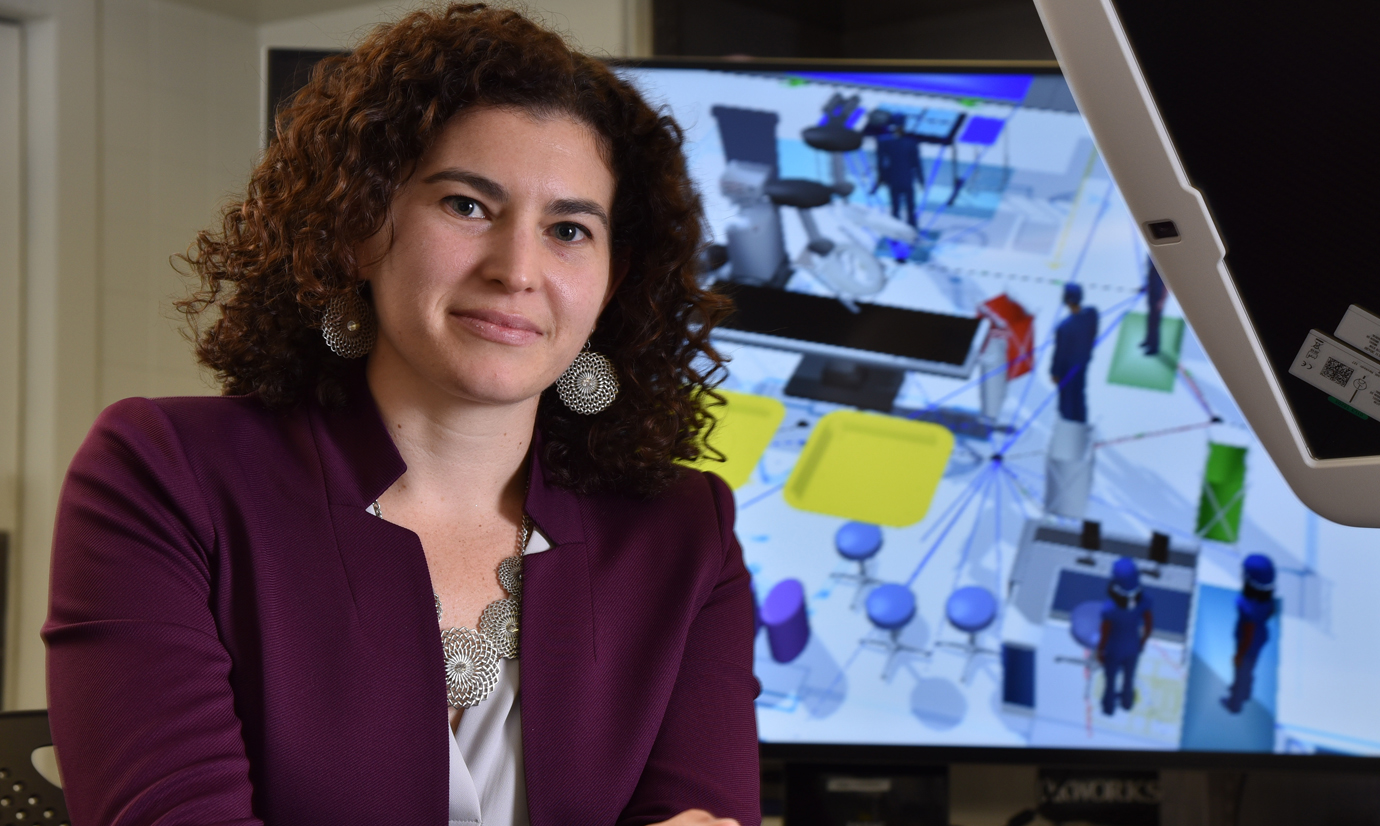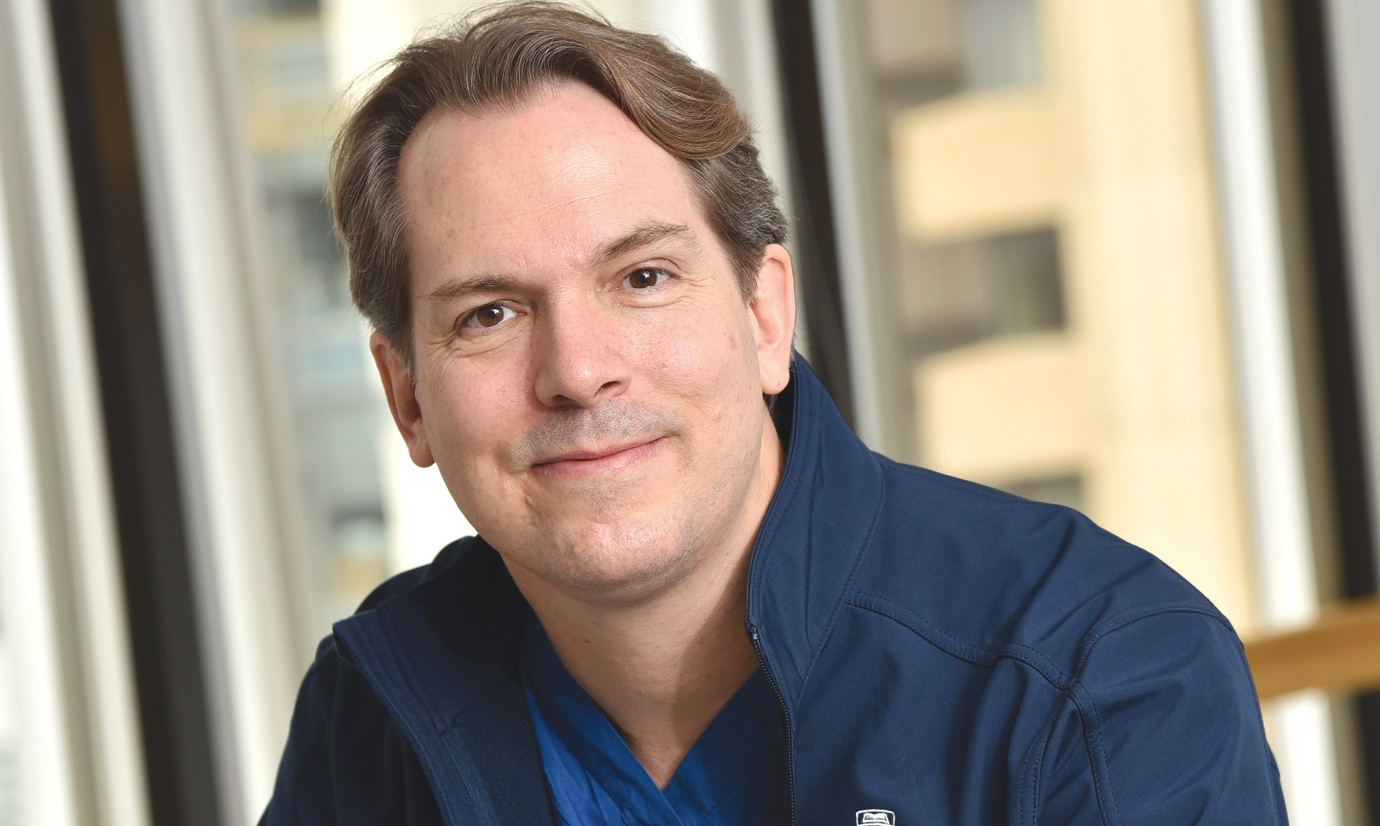As a Halsted surgery resident at Johns Hopkins, Sandra DiBrito fields many queries when she teaches skills in surgical technique to medical students at the school of medicine.
“The main questions are, ‘Am I doing this right? Am I turning my hand the right way?’ Medical students are so busy absorbing the technique,” she says.
But since the September 2018 launch of the Surgery for Engineers program in the Department of Biomedical Engineering, DiBrito hears a different question: “Why?”
“Surgeons take the tools we use for granted,” she says. “Engineers approach everything as a problem. They are about the why.”
DiBrito and several school of medicine surgeons, clinical staff members and administrators are enthusiastic partners in the full-year “Surgineering” program, a graduate-level course series created by Jeff Siewerdsen, vice chair for clinical and industry translation in the Department of Biomedical Engineering.
Siewerdsen talks animatedly about the “surgineer” as a new kind of engineer — one who will become an increasingly essential member of the clinical workforce. With a foundation in biomedical engineering, expertise in systems and data science, and a genuine understanding of interventional procedures, “the surgineer will be equipped to apply perspectives of systems engineering and data science to improving workflow and patient safety in the OR,” he says.
In the fall semester, the Surgery for Engineers course takes 20 or so graduate students from the Whiting School of Engineering and the Johns Hopkins University School of Medicine through 13 areas of interventional medicine, including general and specialized surgeries, interventional radiology, and radiation oncology. The surgineers scrub in to learn surgical skills, such as the basics of suturing, cautery and wound closure, and they practice taking biopsies and placing endoscopes. They also learn who’s who in the OR and how to safely attach a scalpel blade on a handle.
“This class gets at fundamentals. For a biomedical engineer, there is no better way to spark ideas on important problems than to connect with clinicians,” says Siewerdsen, who is also co-director of the Carnegie Center for Surgical Innovation at The Johns Hopkins Hospital.
DiBrito, who helped Siewerdsen develop the first few classes on surgical techniques and tools, is a convert. “Anyone who wants to design tools for surgeons ought to have a baseline understanding of the tools we use,” she says. “You don’t need to design a multibillion-dollar tool. You can design something very simple that will make our lives as surgeons easier. The techniques we show them are magical to the engineers. They ask, ‘Why isn’t it cordless? Why does it use this voltage?’ — the kinds of things I never thought of.”
On a bright November morning in the Carnegie Center, interventional radiologist Clifford Weiss ’99 shows the surgineers how to use ultrasound to guide an automatic needle to locate and perform a biopsy on a tumor in a patient. In this case, the “patient” is a raw turkey breast riddled with pimento olive “tumors.” At another set of tables, other surgineers are set to practice microwave thermal ablation (MTA) on cow’s liver stuffed with blueberries. Guided by Marci Brown, a company representative, they use a minimally invasive MTA system offered by Johnson & Johnson.
After watching a brief demonstration of the tools, the students get right to work — and quickly discover that using the technology is trickier than it looks. As they struggle to synchronize their hand movements with what they see on the screen, Weiss, Siewerdsen and Brown walk around the room observing, offering advice and prompting questions about design challenges.
“Engineering in a vacuum has a lower chance of affecting patient care,” says Weiss as he coaches three surgineers on proper needle placement. “When you identify needs in real time and understand physicians’ difficulties, that’s when you engineer effectively.”

A Synchronous Dance
In the spring semester, eight students from the fall Surgineering course are selected for the program’s second offering, which involves shadowing Johns Hopkins surgeons, nurses and staff members inside and outside the OR. The students concentrate on workflow, the interaction among multiple departments, and the continuous capture and curation of data, all in an effort “to overcome complexity, improve quality and enable new advances in clinical care,” says Siewerdsen.
DiBrito is quick to point out that the physicians benefit as much from the shadowing as the surgineers. “When a surgineer asks a question, it forces you to stop and think,” she says. “Surgineering helps us look at our own work in more innovative ways. Every little, tiny thing has room for improvement, from trauma surgery to microsurgery.”
By midterm, projects crystallize in a lively idea-mapping session with footlong Post-It notes and much discussion. The group narrows its efforts to four projects that it tackles through the rest of the semester with final presentations to an audience of engineers and clinical collaborators in May.
Sarah Capostagno, a Ph.D. student in biomedical engineering who is applying to medical school to be a neurosurgeon (inspired, yes, by the Surgineering program), completed both courses last year. For her project, she and her team designed a better workflow for the intraoperative MRI. The special operating suite contains a mobile MRI machine that gets deployed during surgery to bring the magnet to the patient via ceiling-mounted rails.
The MRI allows surgeons to better see and avoid critical structures in the brain; perform minimally invasive, image-guided procedures; and confirm in the operating room whether the surgery has been successful or if more needs to be done and/or corrections need to be made before the incision is closed.
While observing cases, Capostagno noticed the potential for safety issues and workflow inefficiencies, including the transitions to prepare for the magnet to be brought into and out of the operating area. “For example, I saw that there was time wasted trying to find appropriate cables to stretch to the machine and to the patients,” she says. “I knew it could be fixed with an engineering solution.”
To move from the “Why?” to the “How can this be improved?,” Capostagno simulated the workflow and the roles of everyone in the room: surgeons, anesthetists, nurses, techs and patients. In her models, she rearranged roles, schedules, equipment placement in the room, and how to get people in and out. “My role was to make the dance of people more synchronous,” she says.
One important solution she came up with was to lessen the rotation of the floor-mounted patient table, which decreased the risk of tubes, lines or cables getting tangled or disconnected. She also changed the placement of the anesthesia cart, to be at the patient’s head during intubation. “This relocates the anesthesiologist and anesthesia cart into an area of the room where they don’t have to move during the transition to deploy the magnet, improving time and safety,” she says.
Ultimately, her plan shaved 12 minutes off the setup stage for the room.
“When I was doing it, it seemed basic to me,” she recalls. “But when I showed the clinicians, they were impressed and agreed that it could work.” They encouraged Capostagno to present her plan to The Johns Hopkins Hospital’s governance safety committee and to a team of engineers in the Armstrong Institute for Patient Safety and Quality. “They’re talking about implementing my recommendations,” she says. “This proves that little things that make sense to me have an impact.”

A Fresh Set of Eyes
Richard Day devoted three decades to helping NASA tackle its systems engineering challenges before joining Johns Hopkins in 2007, where he now leads efforts to apply systems engineering methodology and high-reliability principles to enhance the safety and quality of health care.
Day is passionate about bringing a systems engineering perspective to the OR. “The clinicians’ focus is caring for patients,” he says. “You get used to the workflow and operational constraints. It’s that fresh set of eyes that sees the inefficiencies and potential risks. That’s what systems engineering is all about: making sure all elements of the system are working well together, and that risks are proactively identified and mitigated.”
Day presents a fall capstone lecture to the surgineers, and he is working with Siewerdsen to develop a stronger systems engineering thread throughout the Surgineering program.
“Health care has worked diligently to improve safety and quality, but there is still a lack of understanding about well-integrated, highly reliable systems,” says Day. “Health care systems are very complex. We need to optimize for system efficiency and improve the reliability of the various connections among people, processes, technology and information.”
This is precisely why Siewerdsen created the Surgineering program. “My hope is that surgineering will give students insight on both routine practice and major unsolved — often unarticulated — problems,” he says. “These are the brightest biomedical engineering students in the country, and they are the ones who will help transform medical practice in the decades ahead.”
Day lauds the possibilities: “To have the top biomedical engineering program in the country lead the way is critically important for the discipline, the health care industry and, ultimately, our patients.”
